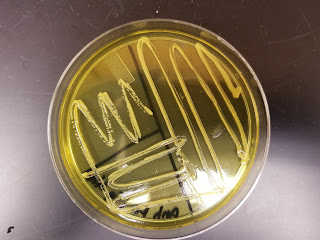Staphylococcus Aureus

Staphylococcus Aureus on Mannitol Plate S. Aureus was identified in two of the participants in my study. Although this organism is typically described as an opportunistic pathogen, it is a part of the normal skin flora of approximately 1/4 of the US population. S. Aureus is also associated with dry skin and atopic dermatitis (Williams et al, 2017). Consistent with current research, the person in our dry skin condition had the most colonies of S. Aureus when compared to the participants with normal and combination skin. Biochemical characteristics of S. Aureus include, mannitol +, coagulase +, glucose +, lactose (+) or (-) , and anaerobic.


